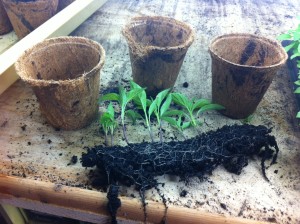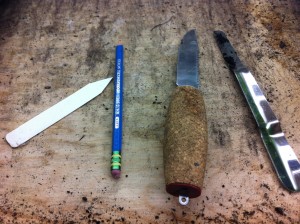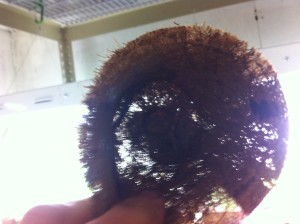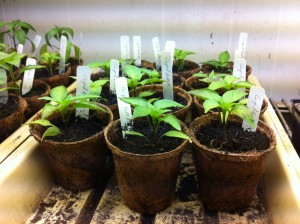It’s a feverish time of the season, when seedings from weeks past wash up on the shores of this week as young plants needing to be transplanted to larger pots. Plus there’s still this week’s seeding to do, plants to be planted out-of-doors, weeding, harvesting, and then the rest of life….hence the fever.
While certain crops like lettuce fairly fly from seed room to outdoor bed, with a few days’ transition to accustom them to the bright sun, there are other plants, like our beloved Solanums, that require more time under lights. Not quite ready for the outdoors (no matter how warm it was in early spring, too-low nighttime temps still rear their ugly heads), low-latitude perennials must still be coddled in our seed rooms and greenhouses before being released as our treasured summer annuals on the 45th parallel. I am, of course, referring to peppers, eggplant, and tomatoes.
Tomatoes deserve their own post or two or three during the summer, and eggplant may yield a thought or two worth mentioning, but for now my focus is on peppers because they are the plants in quantity that are confronting me each day in the seed room. Last year I was chastened by too many tomatoes, so I cut back severely on those, but it seems my zest for planting seeped over into a nearby relation – peppers, and so this year I’m looking at modest numbers of tomato starts but a ridiculous quantities of peppers. In early March it seemed so lovely to open pepper packet after pepper packet and seed variety upon variety, but now the chickens have come home to roost, so to speak, and all those little seeds have turned into seedlings, elbowing and crowding each other in their narrow little rows.
First, let’s talk about how I seed peppers. I have come to like the 20-row trays sold by Johnny’s Selected Seeds. They look like this:
This sort of tray helps me stay organized as I seed different varieties of peppers, allowing me to count how many rows of a particular variety I think I need and , ideally, allowing me to note whether that amount of seedlings overdid it or whether I hit the mark (all this provided that proper record-keeping gets done during the process, but I think I can already tell I overdid it). Here are some mature pepper seedlings in their 20-row habitat:
And here is a row that has been removed and is ready for cutting or teasing apart and transplanting into pots.
Before diving in too deep, it’s good to step back and make sure one has the essential tools. In the photo above you can see a special houseplant tool, somewhat of a shoehorn for 20-row trays, enabling one to slide an entire row of plants out with a single motion, provided the root systems are developed and hold the soil together. Of course the “right tool for the job,” almost a clichéd workshop mantra, really does make the work easier, but in the case of the 20-row trays, a common flat-blade screwdriver will do almost as well at lifing the row out for inspection, teasing apart, and transplant.
Here are the other tools I consider necessary for good transplanting. You see the shoehorn thing I already mentioned. There’s a knife (or alternately scissors) for slicing into soil to separate one seedling’s roots from another’s, though this is also sometimes done by hand. AND, most crucially, a supply of plastic tags and a pencil to write down the variety name. Most pepper seedlings look remarkably like most other pepper seedlings, and once you get them out of their nicely marked rows and into pots, woe unto you if you do not tag them immediately. If you think you have a jalapeno but really have a sweet bell pepper, you will be sorely disappointed later on in the season, when the fruit will make things plain. Marking them at the time of potting will ensure that the right variety gets into your garden. To make sure I’m on target with my tags, I’ll lift and transplant only one variety at a time, tag them all, then move on to the next kind.
Finally a word about pots. I have grown to prefer coconut fiber pots that I can get at my local nursery. You can see that when backlit, a substantial insubstantialness appears. This is a good thing. Provided the pots hold the soil (which they most certainly do), the pot’s porosity allows roots to grow right into soil when you finally transplant them outdoors (pot and all!). No shock from jostling root systems, as sometimes happens with the bottom thwacking required when transplanting from plastic pots. I can also load these pots in solid-bottomed trays and allow the pots and soil to wick up water from the bottom of the tray, making for very convenient and relatively neat plant care.
Eventually you will make your way through all the peppers you’ve seeded. Each will find its coco-pot home for the next month or two, and the fever of indoor transplant season will subside….until, that is, they grow too big for these pots and it’s time to plant them outdoors. But that is another fever and, perhaps, another post.

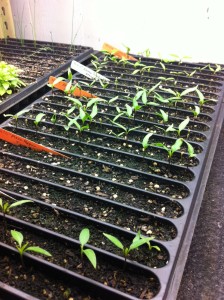
![20rowflat[1]](http://www.urban-ag-solutions.com/wp-content/uploads/2015/04/20rowflat1.jpg)

